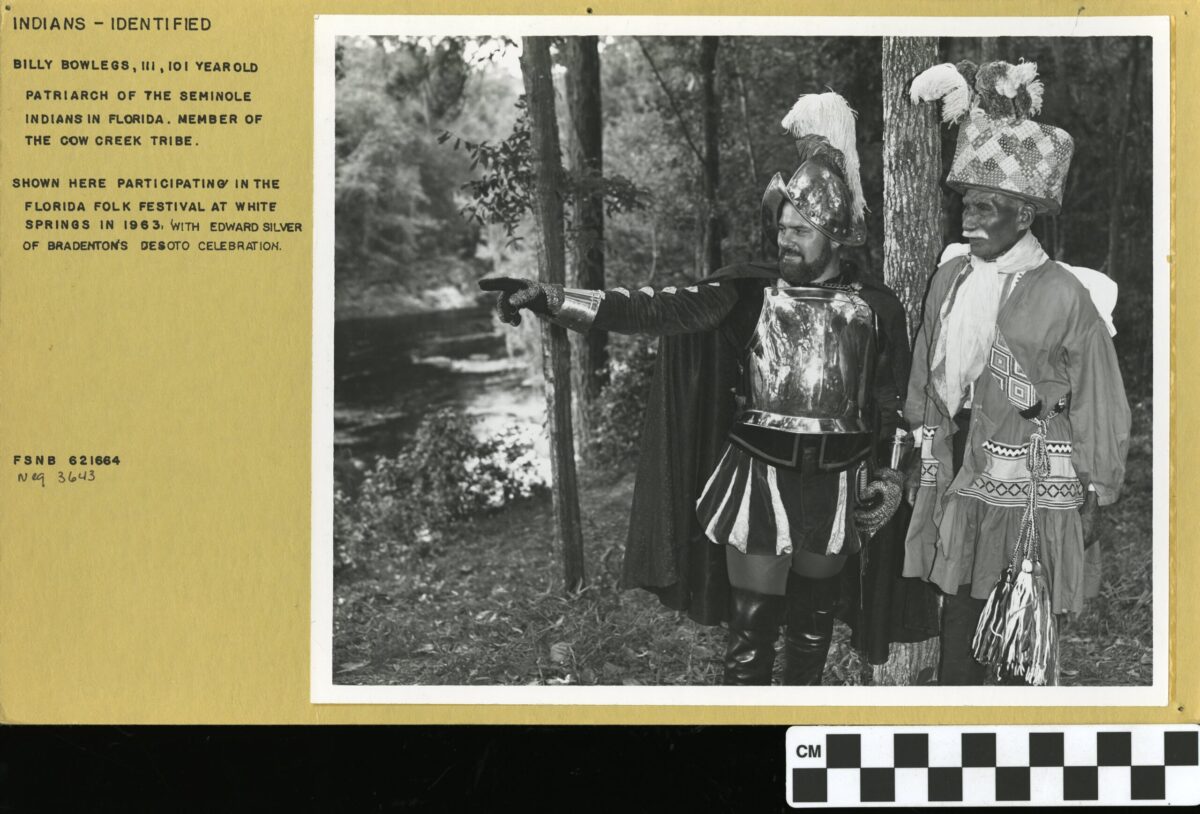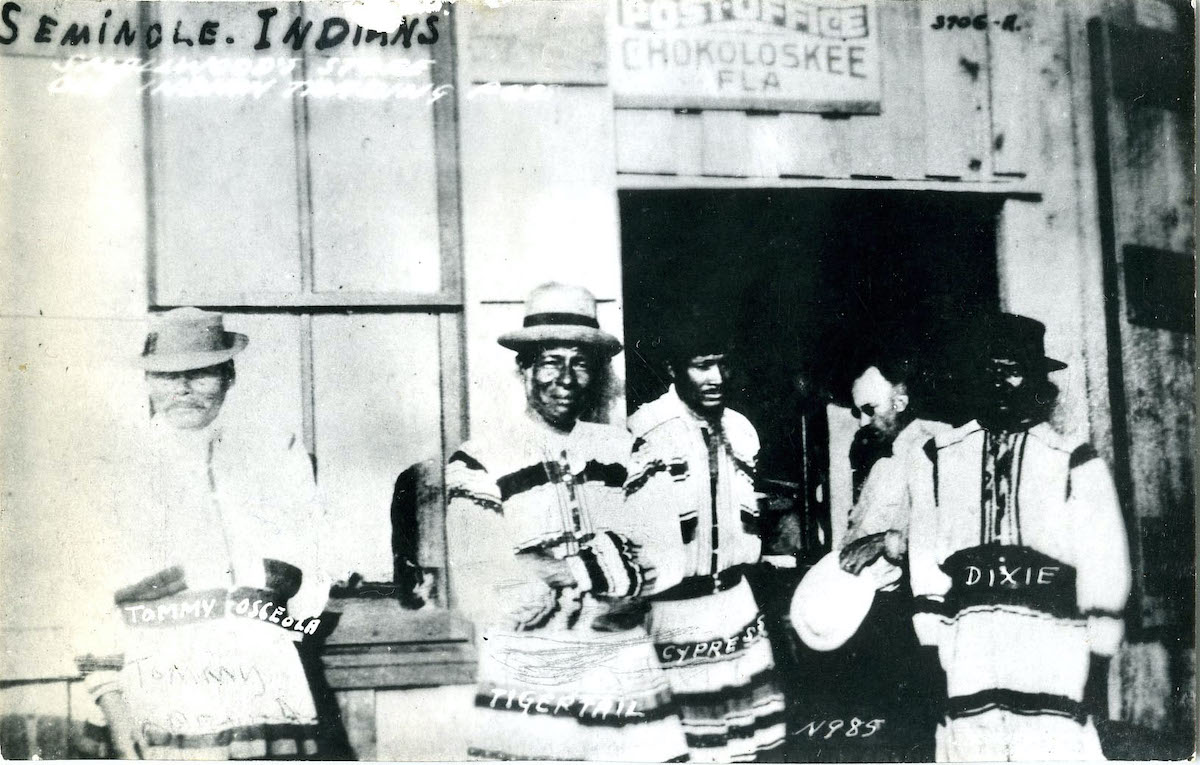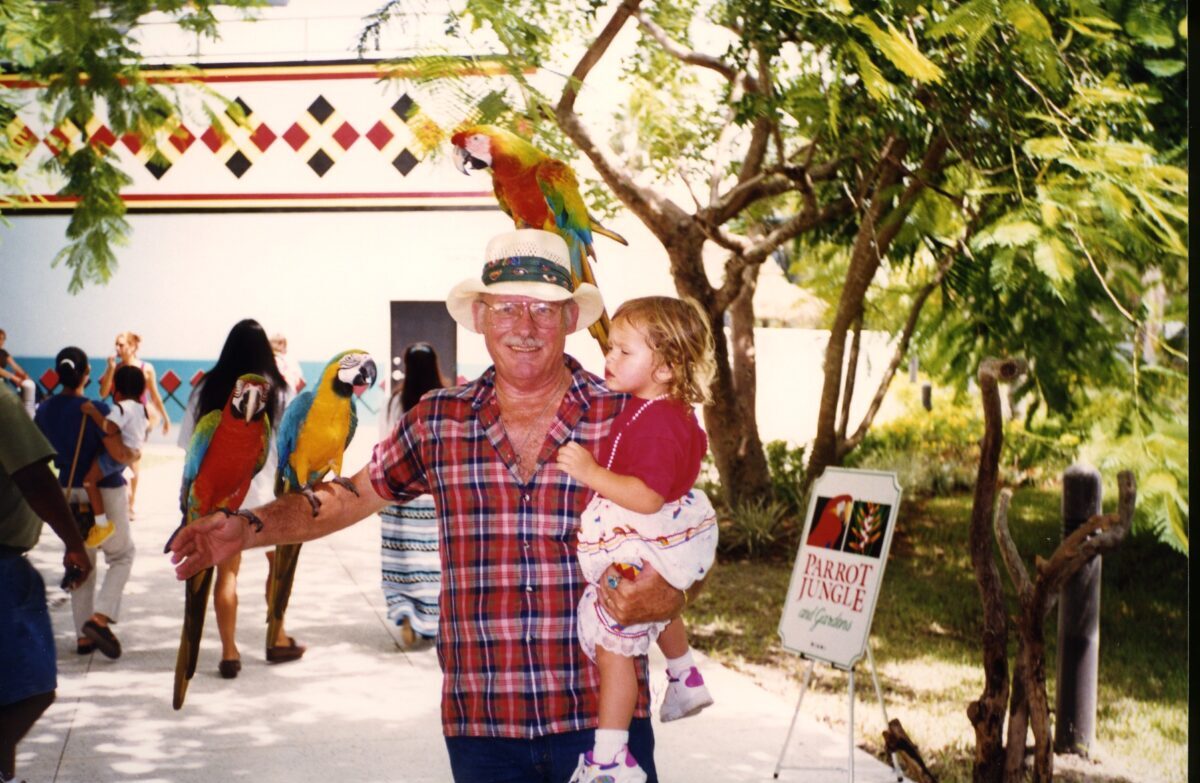
Seminoles Influence Art: Guy LaBree
Seminole culture and traditions have long been a vital part of the fabric and history of Florida and the Southeast. Art is no exception! In this new intermittent series, Seminoles Influence Art, we will explore the Seminole impact on art and artists. As we explore this series, we will see examples of Seminole impacts in music, books, visual arts, and pop culture. This week, we will look at beloved Florida artist, Guy LaBree. Throughout his long career, LaBree depicted numerous scenes of Seminole legends, life, culture, and history. His artwork impacted many Floridians, Seminoles and non-Seminoles alike. This week, join us to explore how he got started, his relationship with the Seminole Tribe of Florida, and his enduring legacy of art.
Below, you can see a black and white image of Guy LaBree holding one of his paintings. LaBree dedicated his artistry toward sharing the history, legends, and culture of the Seminoles of Florida. In our featured image for this week, you can see Guy LaBree and his granddaughter at the reopening of the Okalee Seminole Indian Village and Museum in 1998.

2015.6.14006, ATTK Museum
LaBree’s Connection to the Seminole Tribe
Guy LaBree had a long, robust relationship with the Seminole Tribe of Florida. Growing up near the Dania (now, Hollywood) Reservation, LaBree went to school with many Seminole children and made enduring friendships. Alan Jumper, a lifelong friend who he met in elementary school, was the first to encourage Guy to paint Seminole legends and history. In a 2015 Seminole Tribune article about an Ah-Tah-Thi-Ki Museum exhibit honoring LaBree, Jumper expanded on their friendship and LaBree’s art. Jumper stated “He knew us. He hung out with us all the time. He knew our ways better than any white man.”
Additionally, LaBree was not without support or Seminole input on his art. In the same article, its noted that Jumper, James E. Billie, and Mitchell Cypress often “provided expert advice over the years as LaBree fashioned his paintings.” The exhibit, titled “Guy LaBree: Painted Stories of the Seminoles” ran from June through November, 2015. In addition to his paintings, the exhibit featured several personal items such as his favorite cowboy hat and his famous 60+ lb. palette. Through his paintings, LaBree shared a distinct love and appreciation for the Florida wilderness. He had a distinct style, and was primarily self-taught.
Even now, he has an enduring legacy within the Seminole Tribe of Florida. In that same 2015 Seminole Tribune article mentioned above, HERO director and then director of the Museum and THPO Dr. Paul Backhouse expanded on the breadth of his work. Dr. Backhouse stated “Everyone knew Guy LaBree, or at least were familiar with some of his paintings. They are in government buildings and homes all over the Seminole Tribe…. To think that he created all of those great works of art from that little studio is mind-boggling.”
The Barefoot Artist
A third generation Floridian, LaBree was entranced by the wild vistas, swampland, and untamed prairies of his home. He grew up hunting snakes for money, and was taught to wrestle alligators by childhood friend Alan Jumper. Nicknamed “the Barefoot Artist,” many would be surprised that LaBree didn’t hit his stride as a painter until the mid 1980s. He would become a full-time artist in 1983, after relocating to Australia for a few years before returning to his beloved Florida and settling in Arcadia. Prior to this point, LaBree worked as a lithographer. Soon after, James E. Billie would become his first artistic patron, eventually sponsoring LaBree’s first one-man show. LaBree would go on to have a thirty+ year-long career painting Seminole life, legends, and history. His work would bring him national acclaim, as well as cement his legacy as a great Florida artist.
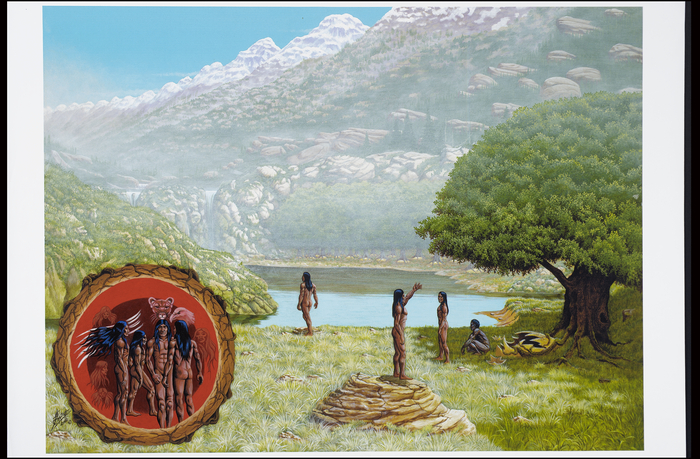
LaBree, Guy. Exodus. 2000-2001. Oil on Canvas. Original painting commissioned by the Seminole Tribe of Florida in 2000-2001; print donated to NMAI by the Seminole Tribe of Florida in 2003.
Exodus and Genesis
In 2004, two of LaBree’s paintings were commissioned by Seminole Tribe of Florida and Sonny Billie to be donated to the grand opening exhibit of the National Museum of the American Indian (NMAI). The two pieces, titled Genesis and Exodus, are visual depictions of the Seminole creation myth as told by Sonny Billie. Above, you can see Exodus. Working on the two paintings, and their eventual induction into the National Museum of the American Indian (NMAI) was a highlight of his career.
In Carol Mahler’s Guy LaBree: Barefoot Artist of the Florida Seminoles, Mahler describes the collaboration process between Billie and LaBree. LaBree had Billie tell him the creation story repeatedly, learning in the oral tradition. LaBree sourced each detail from Billie’s oration, saying “The only thing in these paintings that is mine is the waterfall. I couldn’t figure out how else the water could get there” (Mahler 21). LaBree would produce three prototypes. Labree showed the paintings to multiple Tribal Members for critiques, making sure each detail was correct and authentic. After multiple rounds of edits and changes, the final pieces were complete, immortalizing Billie’s depiction of the creation story for generations to come.
Legends of the Seminoles by Betty Mae Jumper
Another highlight of LaBree’s career was his work on Legends of the Seminoles by Betty Mae Jumper. Legends of the Seminoles was published for the first time in 1998. A stunning collection of Seminole legends, Betty Mae’s words are brought to life by LaBree’s naturalistic paintings and fierce attention to detail. Below, you can see an oil painting on canvas. It features a Seminole woman rubbing corn from her legs while a boy watches from behind a tree. Now, each of LaBree’s paintings used to illustrate the book resides in the Ah-Tah-Thi-Ki Museum Collection. This image is on the cover of the second edition printing of that book, which we profiled last summer on the blog.
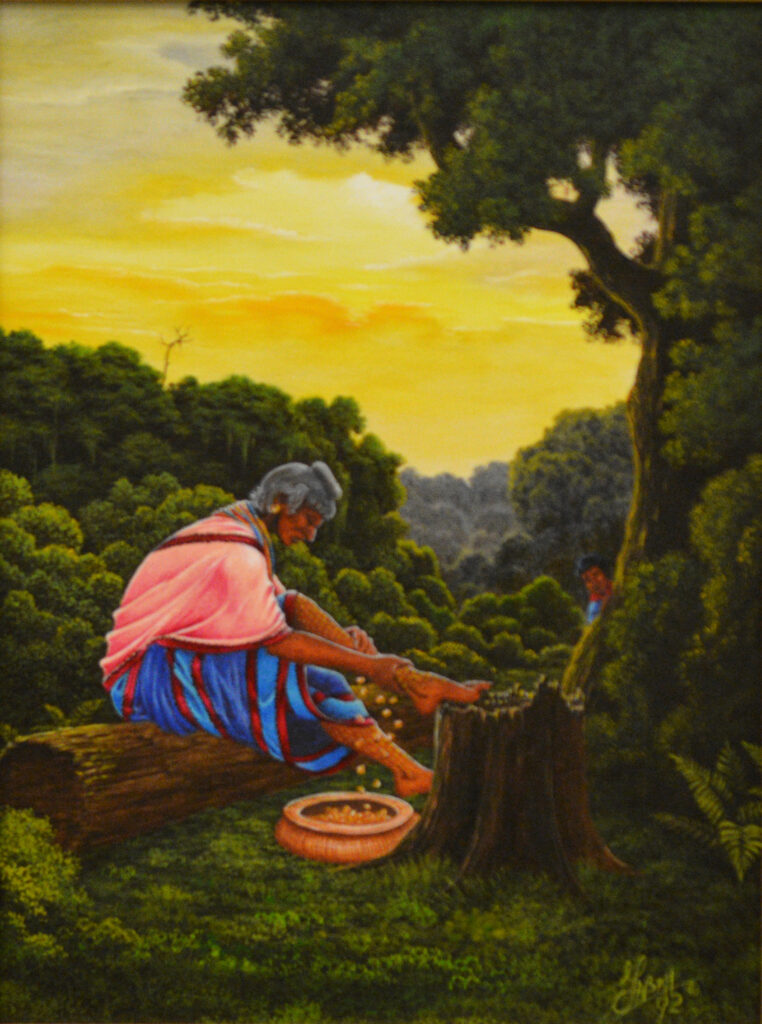
1992.8.1, ATTK Museum
Florida Folk Award and Beyond
Guy LaBree received the Florida Folk Heritage award in 2014. In a 2014 Seminole Tribune article, former Chairman James E. Billie is cited as nominating LaBree for the Florida Folk Heritage Award. In his letter nominating Labree, Billie wrote “I have seen many famous artists and their paintings of Seminoles and Seminole life. Guy LaBree, however, tops them all with his accurate depictions of the way of life of the Seminole.” LaBree would receive the award in recognition of his work to preserve and authentically represent Seminole life, history, culture, and experience.
In his award, LaBree is described as “a folklife advocate guided by unparalleled sensitivity and understanding, [who] devoted himself to bridging cultural and generational gaps with his paintings of traditional Seminole life.” In addition to the Florida Folk Heritage Award, the Florida Artists Hall of Fame inducted and honored LaBree in 2020. He also received the 2011 Stetson Kennedy Award, as well as the 2009 Steve Blackwell Living Heritage Award.
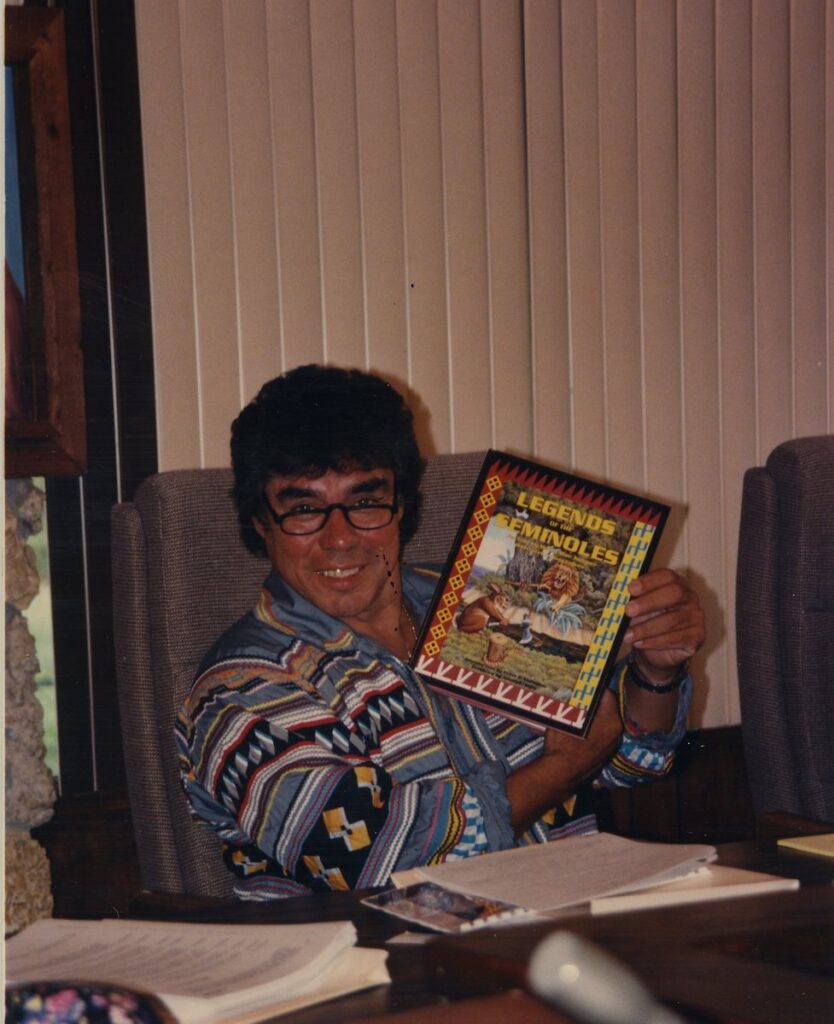
2015.6.12987, ATTK Museum
Above, you can see James E. Billie in the Tribal Council chambers at STOF Headquarters holding a copy of Legends of the Seminoles.
Legacy
Beyond his awards and paintings hanging in galleries, LaBree is remembered as someone who was not only a friend, but also richly committed to authentically representing the Seminole experience. In the afterword of Carol Mahler’s Guy LaBree: Barefoot Artist of the Florida Seminoles, Elgin Jumper (son of Alan Jumper) described LaBree and his work. Jumper states “There is only one artist I know of who has consistently captured on canvas the spirit of the Seminole, for Seminoles, and that artist is no other than Guy LaBree” (Mahler 135). LaBree’s legacy continues through not only his paintings, but also the memories of those who knew, loved, and celebrated him and his art throughout his long career.
A master artist in his own right, Jumper would go on to emphasize the impact of his life and legacy. He continued that “Guy has proven himself the preeminent artist of Seminole history, and he continues to treasure the remaining Florida wilderness, the traditional home and ally of the Seminoles. There is a sacred joy in painting and in art, and this is quite evident in the life and work of Guy LaBree. In his paintings, his well-grounded truth is personified. His knowledge, experiences, stories, anecdotes, and insights about the Seminoles of Florida are considerable, rich, and vivid” (Mahler 136).
Even posthumously, LaBree continues to be an important figure in Seminole art, one that will be remembered and celebrated in Florida and beyond for generations. If you would like to see more of LaBree’s work, we encourage you to explore the Ah-Tah-Thi-Ki Museum Online Collections, or pick up a copy of Legends of the Seminoles by Betty Mae Jumper.
Additional Sources
The author accessed these sources digitally. Page reference numbers may not align with paper and hardback copies.
Mahler, Carol. Guy LaBree: Barefoot Artist of the Florida Seminoles. 2010. University of Florida Press. Digital.
Author Bio
Originally from Washington state, Deanna Butler received her BA in Archaeological Sciences from the University of Washington in 2014. Deanna moved to South Florida in 2016. Soon, she began working for the Seminole Tribe of Florida’s Tribal Historic Preservation Office. Deanna was the THPO’s Archaeological Collections Assistant from 2017-2021. While at the THPO, Deanna worked to preserve, support, and process the Tribe’s archaeological collection. She often wrote the popular Artifact of the Month series, and worked on many community and educational outreach programs. She lives in Fort Myers, FL with her husband, son, and dog.


